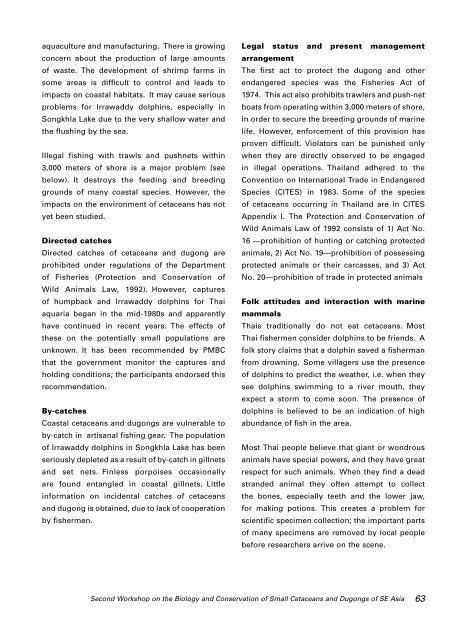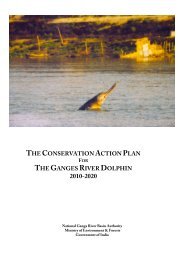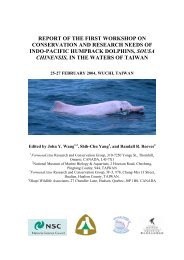Report of the Second Workshop on The Biology and Conservation of ...
Report of the Second Workshop on The Biology and Conservation of ...
Report of the Second Workshop on The Biology and Conservation of ...
You also want an ePaper? Increase the reach of your titles
YUMPU automatically turns print PDFs into web optimized ePapers that Google loves.
aquaculture <strong>and</strong> manufacturing. <strong>The</strong>re is growingc<strong>on</strong>cern about <str<strong>on</strong>g>the</str<strong>on</strong>g> producti<strong>on</strong> <str<strong>on</strong>g>of</str<strong>on</strong>g> large amounts<str<strong>on</strong>g>of</str<strong>on</strong>g> waste. <strong>The</strong> development <str<strong>on</strong>g>of</str<strong>on</strong>g> shrimp farms insome areas is difficult to c<strong>on</strong>trol <strong>and</strong> leads toimpacts <strong>on</strong> coastal habitats. It may cause seriousproblems for Irrawaddy dolphins, especially inS<strong>on</strong>gkhla Lake due to <str<strong>on</strong>g>the</str<strong>on</strong>g> very shallow water <strong>and</strong><str<strong>on</strong>g>the</str<strong>on</strong>g> flushing by <str<strong>on</strong>g>the</str<strong>on</strong>g> sea.Illegal fishing with trawls <strong>and</strong> pushnets within3,000 meters <str<strong>on</strong>g>of</str<strong>on</strong>g> shore is a major problem (seebelow). It destroys <str<strong>on</strong>g>the</str<strong>on</strong>g> feeding <strong>and</strong> breedinggrounds <str<strong>on</strong>g>of</str<strong>on</strong>g> many coastal species. However, <str<strong>on</strong>g>the</str<strong>on</strong>g>impacts <strong>on</strong> <str<strong>on</strong>g>the</str<strong>on</strong>g> envir<strong>on</strong>ment <str<strong>on</strong>g>of</str<strong>on</strong>g> cetaceans has notyet been studied.Directed catchesDirected catches <str<strong>on</strong>g>of</str<strong>on</strong>g> cetaceans <strong>and</strong> dug<strong>on</strong>g areprohibited under regulati<strong>on</strong>s <str<strong>on</strong>g>of</str<strong>on</strong>g> <str<strong>on</strong>g>the</str<strong>on</strong>g> Department<str<strong>on</strong>g>of</str<strong>on</strong>g> Fisheries (Protecti<strong>on</strong> <strong>and</strong> C<strong>on</strong>servati<strong>on</strong> <str<strong>on</strong>g>of</str<strong>on</strong>g>Wild Animals Law, 1992). However, captures<str<strong>on</strong>g>of</str<strong>on</strong>g> humpback <strong>and</strong> Irrawaddy dolphins for Thaiaquaria began in <str<strong>on</strong>g>the</str<strong>on</strong>g> mid-1980s <strong>and</strong> apparentlyhave c<strong>on</strong>tinued in recent years. <strong>The</strong> effects <str<strong>on</strong>g>of</str<strong>on</strong>g><str<strong>on</strong>g>the</str<strong>on</strong>g>se <strong>on</strong> <str<strong>on</strong>g>the</str<strong>on</strong>g> potentially small populati<strong>on</strong>s areunknown. It has been recommended by PMBCthat <str<strong>on</strong>g>the</str<strong>on</strong>g> government m<strong>on</strong>itor <str<strong>on</strong>g>the</str<strong>on</strong>g> captures <strong>and</strong>holding c<strong>on</strong>diti<strong>on</strong>s; <str<strong>on</strong>g>the</str<strong>on</strong>g> participants endorsed thisrecommendati<strong>on</strong>.By-catchesCoastal cetaceans <strong>and</strong> dug<strong>on</strong>gs are vulnerable toby-catch in artisanal fishing gear. <strong>The</strong> populati<strong>on</strong><str<strong>on</strong>g>of</str<strong>on</strong>g> Irrawaddy dolphins in S<strong>on</strong>gkhla Lake has beenseriously depleted as a result <str<strong>on</strong>g>of</str<strong>on</strong>g> by-catch in gillnets<strong>and</strong> set nets. Finless porpoises occasi<strong>on</strong>allyare found entangled in coastal gillnets. Littleinformati<strong>on</strong> <strong>on</strong> incidental catches <str<strong>on</strong>g>of</str<strong>on</strong>g> cetaceans<strong>and</strong> dug<strong>on</strong>g is obtained, due to lack <str<strong>on</strong>g>of</str<strong>on</strong>g> cooperati<strong>on</strong>by fishermen.Legal status <strong>and</strong> present managementarrangement<strong>The</strong> first act to protect <str<strong>on</strong>g>the</str<strong>on</strong>g> dug<strong>on</strong>g <strong>and</strong> o<str<strong>on</strong>g>the</str<strong>on</strong>g>rendangered species was <str<strong>on</strong>g>the</str<strong>on</strong>g> Fisheries Act <str<strong>on</strong>g>of</str<strong>on</strong>g>1974. This act also prohibits trawlers <strong>and</strong> push-netboats from operating within 3,000 meters <str<strong>on</strong>g>of</str<strong>on</strong>g> shore,in order to secure <str<strong>on</strong>g>the</str<strong>on</strong>g> breeding grounds <str<strong>on</strong>g>of</str<strong>on</strong>g> marinelife. However, enforcement <str<strong>on</strong>g>of</str<strong>on</strong>g> this provisi<strong>on</strong> hasproven difficult. Violators can be punished <strong>on</strong>lywhen <str<strong>on</strong>g>the</str<strong>on</strong>g>y are directly observed to be engagedin illegal operati<strong>on</strong>s. Thail<strong>and</strong> adhered to <str<strong>on</strong>g>the</str<strong>on</strong>g>C<strong>on</strong>venti<strong>on</strong> <strong>on</strong> Internati<strong>on</strong>al Trade in EndangeredSpecies (CITES) in 1983. Some <str<strong>on</strong>g>of</str<strong>on</strong>g> <str<strong>on</strong>g>the</str<strong>on</strong>g> species<str<strong>on</strong>g>of</str<strong>on</strong>g> cetaceans occurring in Thail<strong>and</strong> are in CITESAppendix I. <strong>The</strong> Protecti<strong>on</strong> <strong>and</strong> C<strong>on</strong>servati<strong>on</strong> <str<strong>on</strong>g>of</str<strong>on</strong>g>Wild Animals Law <str<strong>on</strong>g>of</str<strong>on</strong>g> 1992 c<strong>on</strong>sists <str<strong>on</strong>g>of</str<strong>on</strong>g> 1) Act No.16 —prohibiti<strong>on</strong> <str<strong>on</strong>g>of</str<strong>on</strong>g> hunting or catching protectedanimals, 2) Act No. 19—prohibiti<strong>on</strong> <str<strong>on</strong>g>of</str<strong>on</strong>g> possessingprotected animals or <str<strong>on</strong>g>the</str<strong>on</strong>g>ir carcasses, <strong>and</strong> 3) ActNo. 20—prohibiti<strong>on</strong> <str<strong>on</strong>g>of</str<strong>on</strong>g> trade in protected animalsFolk attitudes <strong>and</strong> interacti<strong>on</strong> with marinemammalsThais traditi<strong>on</strong>ally do not eat cetaceans. MostThai fishermen c<strong>on</strong>sider dolphins to be friends. Afolk story claims that a dolphin saved a fishermanfrom drowning. Some villagers use <str<strong>on</strong>g>the</str<strong>on</strong>g> presence<str<strong>on</strong>g>of</str<strong>on</strong>g> dolphins to predict <str<strong>on</strong>g>the</str<strong>on</strong>g> wea<str<strong>on</strong>g>the</str<strong>on</strong>g>r, i.e. when <str<strong>on</strong>g>the</str<strong>on</strong>g>ysee dolphins swimming to a river mouth, <str<strong>on</strong>g>the</str<strong>on</strong>g>yexpect a storm to come so<strong>on</strong>. <strong>The</strong> presence <str<strong>on</strong>g>of</str<strong>on</strong>g>dolphins is believed to be an indicati<strong>on</strong> <str<strong>on</strong>g>of</str<strong>on</strong>g> highabundance <str<strong>on</strong>g>of</str<strong>on</strong>g> fish in <str<strong>on</strong>g>the</str<strong>on</strong>g> area.Most Thai people believe that giant or w<strong>on</strong>drousanimals have special powers, <strong>and</strong> <str<strong>on</strong>g>the</str<strong>on</strong>g>y have greatrespect for such animals. When <str<strong>on</strong>g>the</str<strong>on</strong>g>y find a deadstr<strong>and</strong>ed animal <str<strong>on</strong>g>the</str<strong>on</strong>g>y <str<strong>on</strong>g>of</str<strong>on</strong>g>ten attempt to collect<str<strong>on</strong>g>the</str<strong>on</strong>g> b<strong>on</strong>es, especially teeth <strong>and</strong> <str<strong>on</strong>g>the</str<strong>on</strong>g> lower jaw,for making poti<strong>on</strong>s. This creates a problem forscientific specimen collecti<strong>on</strong>; <str<strong>on</strong>g>the</str<strong>on</strong>g> important parts<str<strong>on</strong>g>of</str<strong>on</strong>g> many specimens are removed by local peoplebefore researchers arrive <strong>on</strong> <str<strong>on</strong>g>the</str<strong>on</strong>g> scene.<str<strong>on</strong>g>Sec<strong>on</strong>d</str<strong>on</strong>g> <str<strong>on</strong>g>Workshop</str<strong>on</strong>g> <strong>on</strong> <str<strong>on</strong>g>the</str<strong>on</strong>g> <strong>Biology</strong> <strong>and</strong> C<strong>on</strong>servati<strong>on</strong> <str<strong>on</strong>g>of</str<strong>on</strong>g> Small Cetaceans <strong>and</strong> Dug<strong>on</strong>gs <str<strong>on</strong>g>of</str<strong>on</strong>g> SE Asia 63





